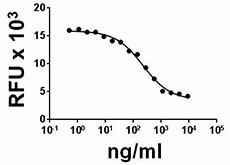- Regulatory Status
- RUO
- Other Names
- Soluble IL-2R, soluble T cell growth factor receptor (TCGFR), soluble TAC antigen (p55), soluble IL-2R alpha, soluble CD25

-

Inhibition of M07e cells proliferation induced by IL-2 in the presence of mouse IL-2Rα.
| Cat # | Size | Price | Quantity Check Availability | ||
|---|---|---|---|---|---|
| 550006 | 100 µg | $633.00 | |||
Select size of product is eligible for a 40% discount! Promotion valid until December 31, 2024. Exclusions apply. To view full promotion terms and conditions or to contact your local BioLegend representative to receive a quote, visit our webpage.
IL-2 was initially identified as a T cell growth factor and plays a key role in the development and homeostasis of Tregs. The IL-2 receptor is a trimeric complex constituted by three different subunits: α (CD25), β (CD122), and common γ (CD132) chains expressed on the surface of activated T cells. Upon activation, immune cells proliferate and CD25 is cleaved from the surface by MMP-2 and MMP-9. Soluble IL-2Rα (sIL-2Rα) binds to IL-2 in vitro, but with a low affinity (kD = 0.03 mol/l) compared with IL-2Rαβγ complex binding of IL-2 (kD = 10−11 mol/l). sIL-2Rα acts as an inhibitor of IL-2 induced T cell responses in vitro. Also, sIL-2Rα enhances Th17 responses in vitro and acts early during Th17 development by inhibiting signaling downstream of IL-2R through its ability to sequester local IL-2. sIL-2Rα exacerbates experimental autoimmune encephalomyelitis and enhances generation of Th17 type responses in the periphery and increases infiltration of CD4+ Th1 and Th17 cell subsets into the central nervous system. sIL-2Rα is considered a clinically valuable tool for several diseases. High serum levels of sIL-2Rα have been observed in sarcoidosis and autoimmune diseases like systemic lupus erythematosus and rheumatoid arthritis. Also, sIL-2Rα is elevated in neoplastic disorders. It appears useful in stimulating survival and monitoring therapy of malignant melanoma or nasopharyngeal carcinoma.
Product Details
- Source
- Mouse IL-2Rα, amino acids (Glu22-Lys236) (Accession# NM_008367), was expressed in CHO cells. 10His-tag in the carboxy terminus.
- Molecular Mass
- The 230 amino acid recombinant protein has a predicted molecular mass of approximately 26.4 kD. The DTT-reduced and non-reduced glycosylated protein migrate at approximately 50 - 58 kD and 40 -55 kD respectively by SDS-PAGE. The predicted N-terminal amino acid is Glu.
- Purity
- >95%, as determined by Coomassie stained SDS-PAGE.
- Formulation
- 0.22 µm filtered protein solution is in PBS.
- Endotoxin Level
- Less than 0.01 ng per µg cytokine as determined by the LAL method.
- Concentration
- 25 µg size is bottled at 200 µg/mL. 100 µg size and larger sizes are lot-specific and bottled at the concentration indicated on the vial. To obtain lot-specific concentration and expiration, please enter the lot number in our Certificate of Analysis online tool.
- Storage & Handling
- Unopened vial can be stored between 2°C and 8°C for up to 2 weeks, at -20°C for up to six months, or at -70°C or colder until the expiration date. For maximum results, quick spin vial prior to opening. The protein can be aliquoted and stored at -20°C or colder. Stock solutions can also be prepared at 50 - 100 µg/mL in appropriate sterile buffer, carrier protein such as 0.2 - 1% BSA or HSA can be added when preparing the stock solution. Aliquots can be stored between 2°C and 8°C for up to one week and stored at -20°C or colder for up to 3 months. Avoid repeated freeze/thaw cycles.
- Activity
- ED50 is 0.2 - 0.6 µg/ml, corresponding to a specific activity of 1.6 - 5.0 x 103 units/mg, as determined by inhibition of M07e cell proliferation induced by human IL-2.
- Application
-
Bioassay
- Application Notes
-
This product is reactive with mouse and human.
BioLegend carrier-free recombinant proteins provided in liquid format are shipped on blue-ice. Our comparison testing data indicates that when handled and stored as recommended, the liquid format has equal or better stability and shelf-life compared to commercially available lyophilized proteins after reconstitution. Our liquid proteins are verified in-house to maintain activity after shipping on blue ice and are backed by our 100% satisfaction guarantee. If you have any concerns, contact us at tech@biolegend.com.
Antigen Details
- Structure
- Receptor
- Distribution
-
Activated T lymphocytes, regulatory T cells, NK cells, monocytes, B cells.
- Function
- sIL-2R acts as an inhibitor of IL-2 induced T cell responses in vitro and enhances Th17 responses in vitro. sIL-2R production is induced upon lymphocyte activation, and it is induced by LPS and IFN-gamma; in monocytes.
- Bioactivity
- Inhibition of M07e cell proliferation.
- Cell Type
- Tregs
- Biology Area
- Immunology, Stem Cells
- Molecular Family
- CD Molecules, Cytokine/Chemokine Receptors, Soluble Receptors
- Antigen References
-
1. Brusko TM, et al. 2009. PLos One 4:e7980.
2. Maier LM, et al. 2009. J. Immunol. 182:1541
3. RusselSE, et al. 2012. PLoS One 7:e47748.
4. Wei L, et al. 2013. Immunity 38:13.
5. Downes K, et al. 2014. Diabetologia 57:366. - Gene ID
- 16184 View all products for this Gene ID
- UniProt
- View information about IL-2Ralpha on UniProt.org
